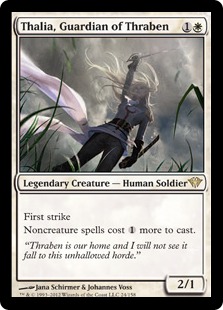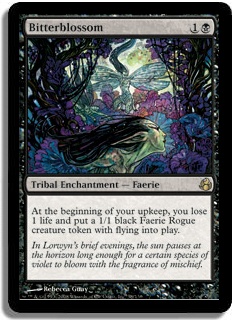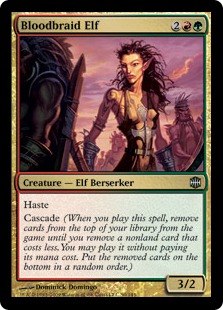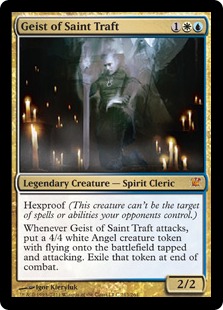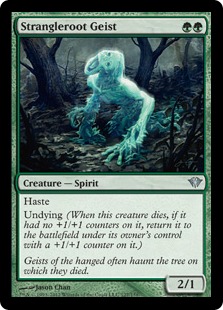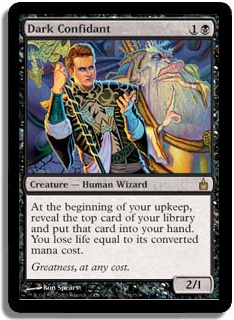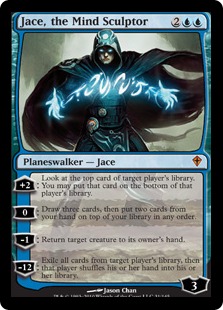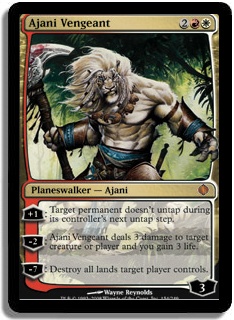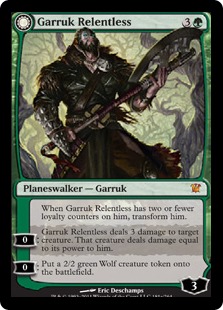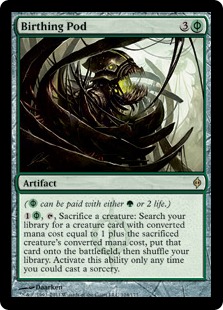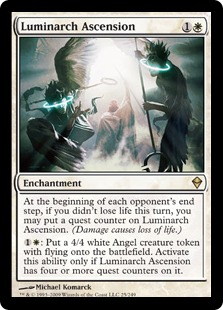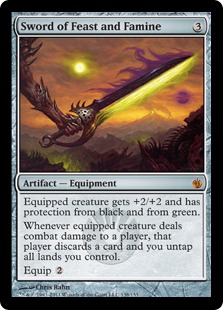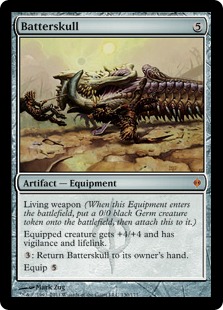There have been many thorns in the sides of control players in the last ten years. Cards that make control players change strategies, revamp decks, and sometimes even bail from their roots. In almost every Standard season, we have persevered with the alterations made to combat cards that were printed for the sole reason of putting a check on the power of control.
Cards made that make us cringe vary in color, mana cost, and type, but all share one constant: they are bad news for expensive sorcery mages everywhere. In this article, I will address what makes a card good against control, what the world would look like without dominating cards printed for aggressive strategies, and at the end the Top 10 scariest cards for control players in recent history.
Why are these cards printed?
Without cards that put a specific hurting on control decks, the game would be unstable and unhealthy. Do I blame R&D for some of the cards? Sometimes. But most of the time I welcome the challenge and immediately begin on creating a strategy to overcome the hate.
Cards that bring control decks down to the level of aggro and midrange decks help prevent a control heavy metagame, which would result in mirror matches galore; that is something no one wants. Believe it or not, most people don’t enjoy playing control. I know that statement is a crazy one and your friends that play aggro and midrange decks say things like, "I like control…BUT…"
It’s not good right now.
I haven’t playtested enough.
I don’t know the format well enough.
I can’t find the right build.
It’s too hard to pilot.
I want more time between rounds to eat.
Excuses are plentiful when players are asked why they don’t play some planeswalkers, Solar Flare, and Grixis. The real reason why people enjoy and continue to use midrange, aggro, and combo decks is because control simply isn’t fun to play and when played incorrectly can result in disastrous records. The printing of cards that make the other strategies besides control viable is the life force that keeps the competitive world revolving.
As a control player…would you want 60% of the field to be control? The answer is no, of course. We enjoy playing against aggro decks and midrange most of the time, and if control did not have checks on it printed on a regular basis the game would be a lot scarier. Control is almost always the minority when breakdowns of formats are created. Calling Caw-Blade or Faeries control is blasphemous…which leads me to the past few Standard metagames.
Even if control is the "best" strategy at the time, let it be Five-Color, U/W, U/B, Urzatron, Teachings, etc., there are always decks that are more played in GPs, PTs and Opens in recent times. Is this lack of control playing a reason that was stated above? Is it because people are not comfortable playing against some of the toughest cards to beat in recent history?
What makes a card good against control?
A 3/1 first strike creature for two mana seems like a great card. It is efficient, puts on a good clock, and isn’t too bad in any matchup. A card like Porcelain Legionnaire is great but is not a card that this article focuses on. Cards that shake the metagame up are special and have certain aspects that make them silver bullets against control players. Let’s take a look at the categorical breakdown.
Resilient Against Countermagic
Some cards that dominate control decks fall under the first category that focuses on countermagic as an answer. The card can either be uncounterable, cheap converted mana cost, cascade, flashback, storm, etc. Cards that truly hurt control decks are almost always "counterable," but counterspells aren’t a sufficient answer.
Bloodbraid Elf can be Mana Leaked… Big deal! The fact that two spells pop out of one card makes a draw-go strategy cringe at the site of this hasted monster. A card like Bitterblossom can be countered…BUT you have one shot at two mana to have the answer or you are in deep trouble. In the current metagame, a turn 2 Thalia results in a loss if the answer is too far away. If you are on the draw and you use this strategy that is another disaster scenario, so cards that fit in this "resilient" category can vary widely.
Continuous Board Threat
Cards that fit under this category create a presence on the board that overwhelms a control player’s resources. Planeswalkers like Ajani Vengeant can put the final nail in our coffin if it resolves due to the lack of pressure that we produce early on in the match. Bitterblossom / Phyrexian Arena produces a threat every turn whether it is card advantage or creature production.
Lands like Moorland Haunt in current Standard drive expensive mages crazy with a constant flying threat every turn, and if unanswered no amount of Day of Judgments will save your life. There are many other types of cards that create a problem every turn starting the moment it is played, and this category is one of the most strenuous to fight against.
Card is too darn good!
Some cards that are made just have too much power. Skullclamp is a perfect example of a card printed that is just overpowered and includes both of the first categories in one. Dark Confidant is another example of a card that is cheap and provides a continuous problem for control players. The big negatives like -1 toughness and losing a life or two per draw step just didn’t seem like enough punishment to put on players using those cards to achieve victory. There are other examples of cards that might not fit in the first two groups but are too powerful nonetheless.
A card that I am scared to death of currently is Zealous Conscripts. It is not cheap and it doesn’t create a continuous threat on the board, but that card resolved against a Gideon or decks that tap out for a Wurmcoil/Titan can see a game that is under control immediately end the wrong way. I am not calling for a banning of the five-mana hasty monster, but this card is as scary as any other and answers besides countering it are pretty worthless.
And now for the list of cards I never want to see ever again!
In no particular order:
10. Thalia, Guardian of Thraben
This two-mana nuisance was mentioned earlier in this article. She comes down and creates a Thorn (of Amethyst) that has to be removed before her other creature friends overwhelm us. On the draw we have to wait until turn 3 to deal with it! Of course, there are those of you who enjoy a Tragic Slip here and there, but for us OGs we like to keep our spells at 2+.
Our Day of Judgments can’t resolve the problem until we hit five mana and cards like Acidic Slime that tend to be buddies in a Naya world take us down an extra notch. Thank goodness we have a new miracle that Wraths for two and that Thalia happens to be a legend, or this nuisance would be moved up a few notches.
9. Bitterblossom
This is the card that made me quit playing control for half a season. I tried everything to beat this low cost enchantment…from changing colors to playing maindeck hate for enchantments, and nothing worked. The threat production of this card is off the chain with evasion creatures being pumped out every turn. Not only did this card make infinite Faeries, but it also turned on other broken cards that all had flash or instant capabilities. The Fae Standard deck had more anti-control cards than any other deck in recent history. Cards like Mistbind Clique, Mutavault, Vendilion Clique, Scion of Oona, (two-mana Fae), Cryptic Command, Ancestral Vision, and Thoughtseize all made control decks nearly go extinct for the better of a year.
Like I said, this deck and Bitterblossom more specifically made the world of control a barren wasteland for players like me. I switched to a ramp strategy and made Top 8 of a few PTQs eventually, but not until I professionally lost to Faeries over and over again. The fact that Fae could operate completely at instant speed put it in a new category of anti-control that was never around prior. Even decks like Delver nowadays have to tap out on their turn once in a while for a Sword or Geist…but that faerie deck was something special. Let’s just say I didn’t lose any sleep when they auto-banned Bitterblossom the day Modern was officially launched as a format.
8. Bloodbraid Elf
Newer players have only heard rumors and stories of one of the games most controversial cards and mechanics. Cascade was an ability that had extreme variance packed with extreme power. The later evolution of Jund allowed that variance to drop to a minimal level, and whatever card came flying out of the deck behind the 3/2 hasted creature was effective to the board or at least did some damage to the player.
This card clearly was a dagger against control decks, but I wouldn’t label it as unfair. This card is obviously powerful and created to be an effective weapon against control, but luckily the primary card casted only is a damage producer. Control players have made a living taking damage, using their life as a resource and waiting until the appropriate time to remove all the creatures from play to gain advantage. Bloodbraid Elf into Blightning was terrible, but mainly because of the Blightning.
The cascading Elf saw play in Naya and other similar aggressive decks, but for the most part the main enemy of control during that era was Jund. I personally stole a PTQ during that season with U/W Control using Emeria Angel as my "tech" against decks that chose to Vengevine us to death. Bloodbraid Elf wasn’t unbeatable, but it clearly was a reason why some games were dominated by Jund.
7)Â Geist of Saint Traft
There is a reason that to this day I don’t want to drop below two Liliana of the Veil even though I feel she is getting weaker with the increased play of G/R Aggro. Geist of Saint Traft is a real threat that is a solid 3-4 of in U/W Delver, which is still a deck that must be defended against. Geist has the ability to steal games and fight through hate geared toward much more fragile Delvers.
Geist is a 6/6 for three that can’t be targeted for all intents and purposes against most control builds. Once that little guy lands in play, the game is nearly over if an answer is not formulated within the next turn or two. Since the Geist happens to be a blue card, you can always expect a full arsenal of counter magic right behind it to ensure its survival and continued damage. Once this card was spoiled I cringed at the thought of playing against it.
Delver is not a powerhouse of a card against control, but that Angel making monster is. The Delver strategy has been to exhaust our resources with their petty threats, and once we cast that single Day of Judgment in our hand you can always expect a slammed Geist of Saint Traft the next turn. That play has resulted in quite a few loses for me personally, but all the signs point to one card for the reason we struggle against the most popular deck in Standard.
6)Â Strangleroot Geist
Unlike his Geist of Saint Traft brother, this little guy is a much more subtle threat that can put a game equally out of reach without you even knowing it. The undying ability was clearly one that developers knew would drastically affect control players. A 2/1 haste for two is already efficient, but adding undying makes it one of the best cards to come from green that I’ve seen in a long time.
Tarmogoyf…pfft he is a joke for us, but this guy is a nightmare. Turn 2 Strangleroot Geist, turn 3 Zenith for Geist, and crush for massive damage starting that early can put games out of reach for us, especially when we are on the draw. In my last article I championed Pillar of Flame, and sometimes I come really close to sleeving up Mountains to deal with threats like this. I switched to red to Volcanic Fallout some Faeries and ramp into some Broodmate Dragons years and years ago, but so far I’ve been able to escape the G/R matchup with a 50/50 win-loss record and that will do for now.
If it wasn’t for Strangleroot Geist, the matchup against Pod and G/R would be a joke because cards like Huntmaster of Fells and Sword of War and Peace are easy to deal with for us. Was Terminus our saving grace versus cards that love to go to the yard? It definitely helped, but don’t take the uncommon haster for granted or it will bury you.
5)Â Â Dark Confidant
This is the small-bodied card-drawing machine that we all hate to see. On turn 2, you feel like the game is getting out of reach turn after turn and card after card. Card draw has been something R&D has worked on tirelessly to make fair, because the person who draws the most cards usually wins the game. If aggro decks start drawing more cards than control decks bad things happen, and Dark Confidant usually is paired with burn spells that tend to outnumber the answers a control deck can muster.
When I discuss the power of Dark Confidant and Geist of Saint Traft, we can’t forget that any deck that uses cards with such powerful potential can beat us with the correct draws. Sometimes you don’t have the answer for a turn 2 Dark Confidant and the game becomes a spectacle where we appear to not even interact on a competitive level, but sometimes we just kill the little critter and we take down the match with ease. Magic is funny like that… Do you have the answer? If so, control mage, you win, but if not then I’ll shake your hand and wish you good luck in the next round.
4)Â Planeswalkers
Planeswalkers are a blessing and a curse for control players. Luckily we have reaped the benefit of this type of permanent much more than aggressive decks have. Planeswalkers are usually expensive, and cards that have high CMC usually don’t find their way into an aggro or midrange deck. With that being said, if enemy decks decide to include one or two into their builds then we have a problem.
Planeswalkers are trouble for us because of the lack of pressure that control players put on their opponents in the early game. The Jace wars before the banning created situations where an unanswered Jace would end the game with ease. This situation of unanswered planeswalkers is a rough example because of their dominance in control decks, but when aggro players decide to throw some Garruk Relentless or Elspeth, Knight-Errant in their decks then control players can’t fight them using the same old strategy.
You can’t Wrath a planeswalker, and you can’t take them to the lategame while those things are ticking higher and higher in loyalty. That leaves us with a dilemma that was answered in the past by Oblivion Rings, our own planeswalkers, or adding some kind of early pressure that we normally wouldn’t include if it wasn’t for our opponents love for permanent threats.
3)Â Birthing Pod
This card makes the list pretty easily. Birthing Pod was immune to Inquisition of Kozilek in old Standard, and when it resolved it presented a problem for the entire game. U/B was the popular control deck last year, and as you well know U/B doesn’t have the equipment to deal with an artifact like that. Torpor Orb in the sideboard supplied some type of relief, but sometimes it isn’t drawn early enough and the card is an eye sore due to its lack of versatility in other matchups.
Birthing Pod alone isn’t the kryptonite for control, but the creatures that pair with the artifact are. Each creature in the deck provides a comes into play ability or a certain amount of efficiency that makes it a Wrath-able creature on its own. Continued use of Birthing Pod creates card advantage and board advantage that no draw-go or tap-out deck can compete with.
Birthing Pod became a frustrating obstacle for U/B, and players dedicated to the cause began to lose hope, including myself. Ali Aintrazi at one point packed massive hate in the board because he was also over the power of that card, and we both soon realized that avoidance was the best policy in regards to that matchup. I thank the heavens that Pod didn’t catch on like it could have then, or we would be in a world of hurt. Currently Naya Pod is still a bad matchup for control, but we do the best we can. Nowadays I am including white in my control build, which allows for better "hate" against Birthing Pod and the creatures that come out of it.
2)Â Luminarch Ascension
This is my pet card that makes the list. It is a control sideboard card that destroys control in a few short turns. One of the key elements of control is survival to the endgame, and that usually constitutes removal over early pressure. Luminarch Ascension sits there patiently and counters build and build. Once the counters reach four, the game is virtually over.
This card is the definition of control hate and is essentially unplayable against midrange and aggressive decks. White aggro decks packed this in the board to add another dimension to their attack plan. Not only do control decks have to combat early pressure, but they have to somehow deal damage to them simultaneously. That strategy is much easier said than done, which is another reason why planeswalkers are so effective against control decks.
Luminarch Ascension never got much love because of its home in the sideboard, but as far as power level goes it is a 10 out of 10 against any control build of the past. It is one of those cards that I loved to have around because many control players didn’t feel they needed additional help in that department, and players like me reaped the benefits of that arrogance. I think it would have had a nice home in Avacyn due to the Angel theme and the slow nature of the format, but I will settle with the memories of a confidant turn 2 stab in the control mirrors of the past.
1)Â Stoneforge Mystic and the Equipment Package
Prior to the printing of Sword of Feast and Famine, I played a U/W Control deck with some moderate success. Pro Tour Paris unleashed the combination of the Kor Artificer and her equipment package on the world and changed Standard forever. We would have to endure the torture of Caw-Blade for months and months, but it wasn’t the birds that haunted us. Stoneforge Mystic already produced card advantage and an uncounterable weapon the next turn, but things were going to get much worse.
Once Batterskull was printed, Stoneforge shot up in value to the point where Wizards would have to eventually ban it. Sword of Feast and Famine was one of those sneaky cards that people underestimated. The ability to untap all of your land and continuously produce card advantage through discard was a powerful force…and you only had to run one! Batterskull created a 4/4 attacker on turn 3 and was also uncounterable with the ability to sneak it into play at end of turn. Both equipment are great against control in general, but with the tutoring ability it became far too powerful.
Control died as we knew it, and it took banning to revive U/B Control against a field that still had a ton of Caw-Blade…just without the cards that made it unstoppable. To this day we have to fight against Sword of War and Peace that can kill us in one swing as well as the Feast and Famine equivalent out of the board. The Swords now are much easier to deal with without the partner that retrieved them however. Swords follow a different rule of control hate. Swords automatically made whatever creature came into play under our opponents control a superstar with amazing abilities.
Our main defense against that today is to blow up the equipment or kill all their creatures, and thankfully it takes a decent mana investment to land and equip one of these monsters. Out of all the cards that are effective against control, these stated equipment and the Stoneforge Mystic are the most powerful because not only are they amazing against control, but they also are very damaging to aggro. That dual effectiveness makes for the field that’s saturated with these cards and that forces us to play cards we normally would not play.
We always say things like, "I can’t wait until Swords rotate," but cards we enjoy seeing rotate will always be replaced with cards just as powerful in their own way. R&D isn’t stupid and although they’ve made mistakes when printing some cards, for the most part they keep the game competitive and balanced. I had a good debate on Twitter with Adrian Sullivan when I made a comment that people will always find reasons to dislike a format and call it unhealthy.
He made a good point that sometimes decks are just unfair and unbalanced, but I’ve told my control brothers and sisters we beg for formats like that. When everyone is playing Affinity, we play Akroma’s Vengeance. When everyone plays broken creatures, we play a lot of Wraths. When everyone plays Faeries, we play green-based ramp/control with Great Sable Stags or red with Fallouts. Control adapts to formats that are leaning towards unfair, and we have the ability, most of the time, to overcome the popular deck of the year.
Powerful cards against control will always be printed, and I implore my readers to not become frustrated or use the line, "Control isn’t good right now." Control might have to run Lingering Souls to block or play with a five-color mana base, but it will always have the tools to be successful. I did mention how I jumped out of control for a brief period just because Volcanic Fallout and Great Sable Stag didn’t exist yet, but once they came out I jumped right back in.
I enjoy the challenge of powerful cards to battle against in Standard, and I welcome the printing of these cards. The more difficult it gets for control to be piloted well, the less that people play it, the less hate people pack in the sideboards for us, and the better our matchups become.
This list of above was not all-inclusive and I left out a lot of cards that could have made the list. This is just my rendition of cards in the last few years that created hurdles for control to leap over. I hope you enjoyed this article, and I’ll be sure to write a small report after the SCG Invitational in Indy with updates for Legacy and Standard Esper. Until next time!
Shaheen
[email protected] — Email
@shaheenmtg – Twitter

